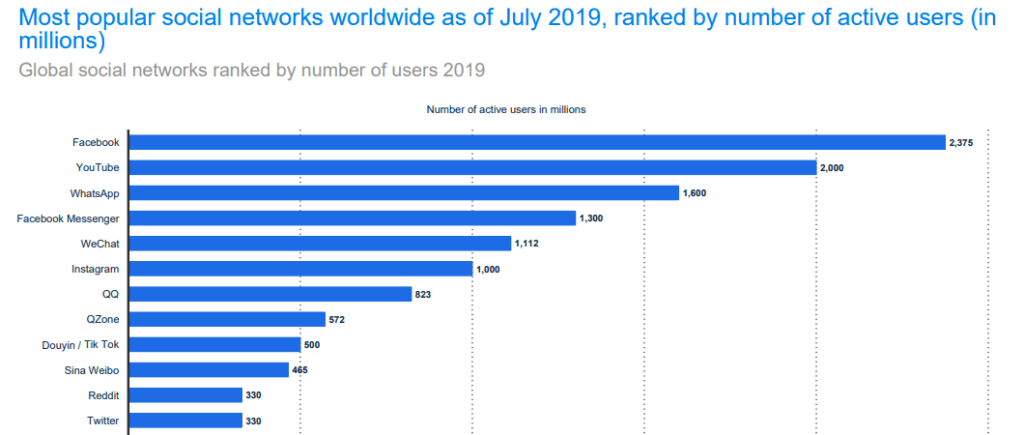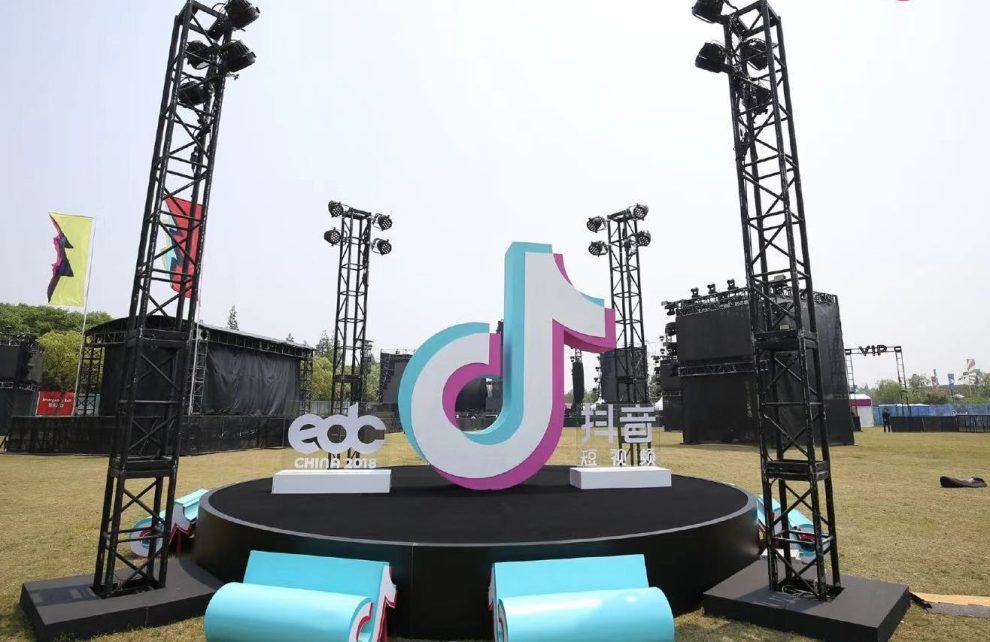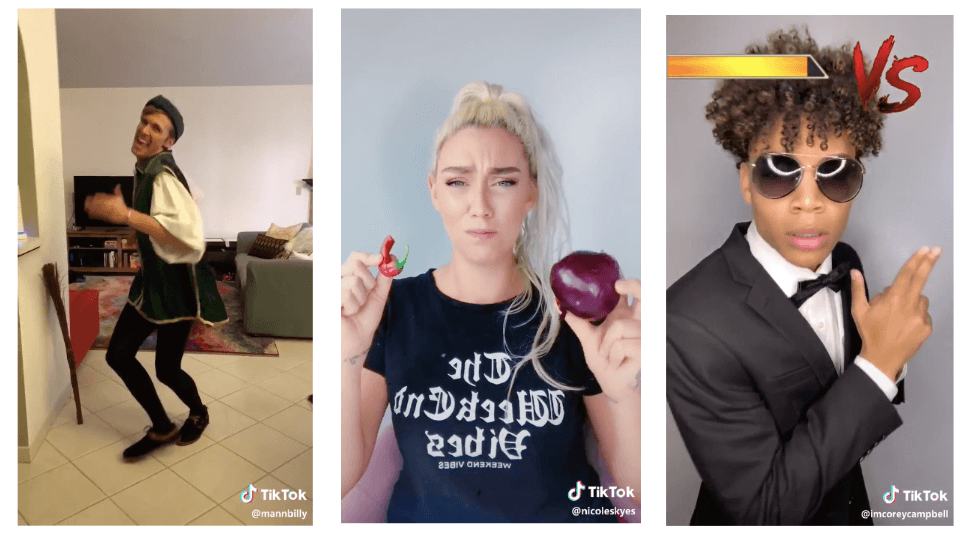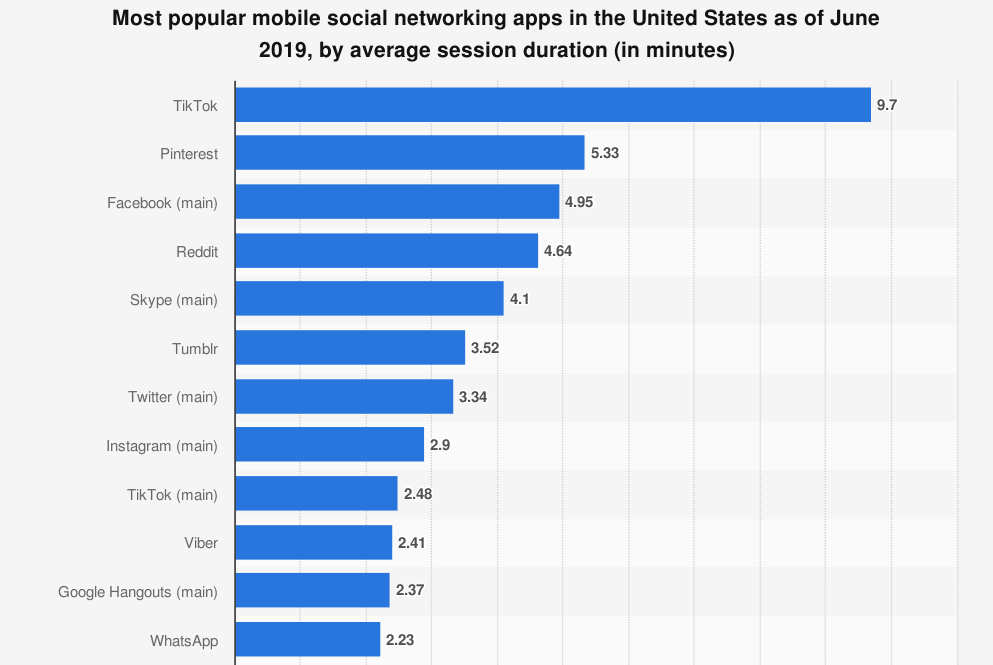TikTok: Transforming Video-Sharing

TikTok is part of the most valuable startup in the world, yet few smartphone users outside of Gen Z have not heard of, much less used, it. When ranked by number of daily active users, TikTok is the only social network application founded in the last ten or so years in the top fifteen [1]. What’s so special about TikTok?
Background
Introduction: Since launching into international markets in 2017, TikTok has secured 500 million active users and, in October of 2018, was the most downloaded app in the App Store for five consecutive quarters [2]. TikTok was created by ByteDance, a China based internet technology company, in 2017 as an internationalequivalent to a video-based application called Douyin. Since acquiring TikTok competitor Musical.ly in 2017, ByteDance has become the most valuable startup in the world with a value of $75 billion [3]. Additionally, Sensor Tower reports that TikTok has been downloaded nearly one billion times on Android and iOS devices worldwide [2]. Despite the indisputable success of TikTok so far, many smartphone users outside of the Gen Z demographic have never heard of the app. To better understand the success of TikTok, it’s important to look at the context in which it was created.

Brief History: TikTok arrived after a slew of social network application launches, particularly video-based apps. Most notably, Vine essentially piloted short-form video creation and sharing. After its launch in 2012, Vine developed a large pool of users but lack of retention and inability to successfully monetize caused parent company, Twitter, to close Vine in 2016. The application centered around a handful of ‘influencers’ who would pivot to YouTube or Instagram after gaining notoriety on Vine [4]. Additionally, Vine was not able to seamlessly advertise without disrupting the user experience. Musical.ly was then launched by Alex Yu in Shanghai. Musical.ly leveraged similar short-form video technology but focused on singing and lip-syncing videos. Some analysts argue that Musical.ly’s focus on the inherently embarrassing activity of lip-syncing created a casual, accessible tone for the app [4]. Likely due to the Musical.ly’s successful partnerships with companies like Coca-Cola and their high visibility in the U.S. market, ByteDance bought Musical.ly in 2017 and merged it into TikTok.
Value
- Democratization of Content Creation: Many video-sharing platforms have minimal resources for users to curate content within the app aside from filters [6]. This limited use-case puts considerable onus on the user to learn and create their content independently. TikTok took a different route by equipping users with internal video creation tools. With TikTok, users can film, add filters, cut/paste clips, overlay audio, leverage sophisticated AR, and more due to the company’s high research investment into “computer vision [and] virtual reality” [6]. The app’s user-friendly interface means that nearly any user can make a wide variety of videos in an instant.
- Semblance of Authenticity: A common complaint against social media platforms is that users cannot be their most authentic selves. As mentioned earlier, TikTok and Musical.ly were created to share videos of singing, dancing, etc. which differs substantially from the micro-blog format of Twitter and photo-focused interface of Instagram. The differentiation is important. The New York Times columnist Kevin Roose ventured to name TikTok “the only truly pleasant social network in existence” because users can “let their guards down [and] act silly” [4]. Moreover, the mood of TikTok allows companies to quickly engage with followers through short, light-hearted content. The video below from the Washington Post is a prime example.
Digital Innovation: ByteDance, TikTok’s parent company, describes themselves first and foremost as a company leveraging artificial intelligence to enhance mobile user experiences [9]. As soon as a new user logs in, a ByteDance patented algorithm begins curating and refining a For You page. The For You page “is constantly learning” as Bytedance’s algorithm ingests the text, content, faces, length, topic, etc. of every video a user interacts with [6]. ByteDance’s investment in AI driven user engagement cannot be ignored as TikTok ranks number 1 in average session duration amongst social networking apps [1] AI capabilities have also enabled effective gamification of TikTok through worldwide challengers every day. Challengers are another opportunity for advertisers such as Jimmy Fallon, whose TikTok challenge amassed over 10 million views in a few days [8].
Concerns
- Political interference: TikTok, and ownership of the data it generates, is based in China. Concerns regarding privacy and censorship have begun to arise.
- Child protection: 41% of TikTok users are between the ages of 16-24 but there are many users above and below this group [10]. The platform must ensure that minor, particularly young girls, are not portrayed inappropriately. The FTC already fined them $5 million for collecting data of users below the age of 13.
- Bullying: TikTok, like nearly every social network, is vulnerable to bullying. As an app with a lot of parodies and “silly” humor, the risk of spreading inflammatory content is high.
Works Cited
- Statista
- Briskman, J. (2019). Top Apps Worldwide for Q1 2019 by Downloads. [online] Sensortower.com. Available at: https://sensortower.com/blog/top-apps-worldwide-q1-2019-downloads [Accessed 17 Oct. 2019].
- The Verge. (2019). How the company behind TikTok became the world’s most valuable startup. [online] Available at: https://www.theverge.com/2018/11/30/18107732/bytedance-valuation-tiktok-china-startup [Accessed 17 Oct. 2019].
- Nytimes.com. (2019). How TikTok Is Rewriting the World. [online] Available at: https://www.nytimes.com/2019/03/10/style/what-is-tik-tok.html [Accessed 17 Oct. 2019].
- https://knowledge.insead.edu/entrepreneurship/the-tiktok-strategy-using-ai-platforms-to-take-over-the-world-11776
- Nytimes.com. (2019). TikTok, a Chinese Video App, Brings Fun Back to Social Media. [online] Available at: https://www.nytimes.com/2018/12/03/technology/tiktok-a-chinese-video-app-brings-fun-back-to-social-media.html?smtyp=cur&smid=tw-nytimes [Accessed 17 Oct. 2019].
- Business Insider. (2019). TikTok was bigger than Instagram last year after passing the 1 billion download mark. [online] Available at: https://www.businessinsider.com/tiktok-hit-1-billion-downloads-surpassing-instagram-in-2018-2019-2 [Accessed 17 Oct. 2019].
- TechCrunch. (2019). It’s time to pay serious attention to TikTok – TechCrunch. [online] Available at: https://techcrunch.com/2019/01/29/its-time-to-pay-serious-attention-to-tiktok/ [Accessed 17 Oct. 2019].
- https://bytedance.com/en/about#overview






As an occasional user of Tik Tok, I was very excited when you featured this platform for your assignment. While at first, I thought that Tik Tok was yet another “gimmicky” app, it seems to have significant benefits for companies as it can be used for marketing and advertising purposes. At the same time, I’m concerned about the business viability of this company as a stand-alone product, as it seems “attached” to other social media platforms like Facebook or Instagram, rather than a source of incoming traffic. If their only revenue stream is advertising for other brands, then where else can the company expand to capture revenues?
Never used it but I’ve heard that TikTok became huge in India once millions of people gained access to cheap internet and smart phones recently. Through TikTok, people who couldn’t read or write text messages interacted in social media just by sharing videos and audio. That opened up a huge market at the bottom of the pyramid. And its spontaneous vibe proves very appealing to Gen Z too, who represent a huge chunk of the market in India.
Hey EKEA, thanks for the post! I’ve been a frequent user of Douyin, the Chinese version of TikTok. I have to say that this APP is super addictive and I sometimes could end up spending an hour browsing through the short videos. I really like your point on democratization of content creation, as both TikTok and Douyin are largely UGC- based platforms that have enabled everyone to make and post videos. I actually have a friend who was able to amass more than four million followers on Douyin within half a year, and became a top-tier influencer. Since earlier this year he also started monetizing from his follower base by selling products directly on Douyin and making commercial endorsements. I’m curious to see how TikTok and Douyin evolve and if they can become more known to a wider audience.
Thanks for the interesting read. Your post inspired me to download TikTok to see what the hype is about but I have to say, as a crusty old millennial, I found it very hard to get into it. That being said, I think the numbers speak for themselves. TikTok has phenomenal user engagement, which should translate into significant monetization potential. I’d be curious to know how much of TikTok’s success can be attributed to their choice of betting on lip-synced videos. It has been 15 years since the OG of lip syncs came out – GMan250’s Numa Numa video posted on newgrounds. I think its just fascinating to see it has become a the most valuable startup in the world. Reference: https://www.youtube.com/watch?v=KmtzQCSh6xk
Very good choice of platform to study, TikTok is definitely shaking the social media industry. I am probably too old for it since I am a little too concern about what its success means for the future of human interaction. Their algorithm, in my understanding, prioritize instant/ephemeral buzz group of random people who happen to simultaneously share content related posts rather than match users with his/her circle of friends or relatives. The algorithm is targeting increase user time and nothing else, as this New York Times articles also suggests, https://www.nytimes.com/2019/03/10/style/what-is-tik-tok.html
You mentioned that content creators are tempted by multi-homing because they cannot make money on the platform. When they do make money as a result of their activity on the platform, often these deals take place off the platform, leaving out TikTok. I am examining TikTok for another class and am considering the following as potential solutions. Very curious to hear your thoughts!
1. YouTube model: AdSense accounts so that brands can contact users through the platform and users can get paid for their content. This solution begs the question of how to weave advertisements into such short-form content.
2. Subscription model: users pay a monthly fee (maybe as little as $0.99) to subscribe to premium content from power-creators, like celebrities. Would this possibly incentivize creators to produce explicit content? TikTok has struggled with this in India where it was temporarily banned for two weeks.
3. Improving in-app purchases: users buy digital currency, “coins”, which they use to “tip” content creators. This is what TikTok does currently, passing 80% of the value of the tip on to the content creator; however, perhaps this model could be improved.
4. Patient strategy: TikTok does nothing.
its remarkable how few people in generations above gen-z have heard about the app. It will be interesting to watch how things unfold. Will it grow into another Facebook? Or decline like snapchat!